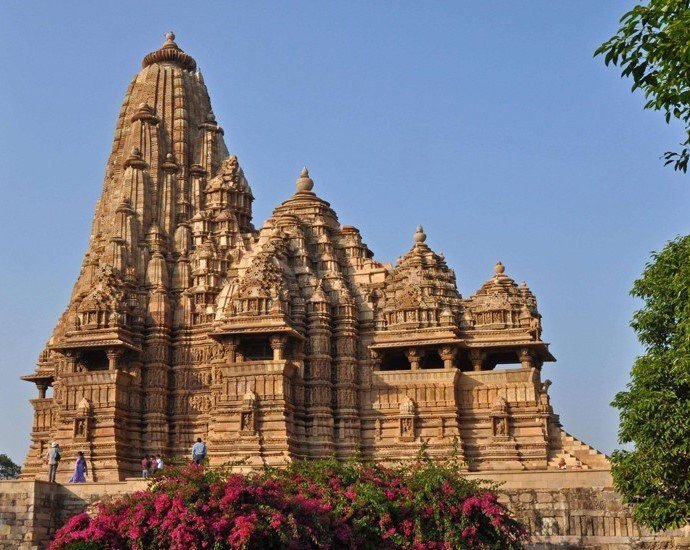Kandariya Mahadeva Temple ( कंदारिया महादेव मंदिर) meaning “Great God of the Cave”, is the largest and most ornate Hindu temple of the group of medieval temples found in Khajuraho in Madhya Pradesh, India . It is considered one of the best examples of preserved temples from medieval times in India.
Location
The Kandariya Mahadeva Temple is located in the Chhatarpur district of Madhya Pradesh in central India. It is in the village of Khajuraho, and the temple complex is spread over an area of 6 square kilometers. It is in the western part of the town west of the Vishnu temple.
The temple complex, in the village of Khajuraho at an elevation of 282 meters, is well connected by road, rail and air services. Khajuraho is 55 kilometers south of Mahoba, 47 kilometers from the city of Chhatarpur to the east, 43 kilometers from Panna, 175 kilometers by road from Jhansi to the north and 600 kilometers southeast of Delhi. It is 9 kilometers from the train station. Khajuraho is served by Khajuraho Airport (IATA code: HJR), with services to Delhi, Agra, and Mumbai. It is located 6 kilometers from the temple.
History
Khajuraho was once the capital of the Chandela dynasty. The Kandariya Mahadeva Temple, one of the best examples of preserved temples from the medieval period in India, is the largest of the western group of temples in the Khajuraho complex that was built by the Chandela rulers. Shiva is the main deity in the deified temple in the sanctum sanctorum.
The Kandariya Mahadeva Temple was built during the reign of Vidyadhara. In various periods of the reign of this dynasty many famous temples were built dedicated to Vishnu, Shiva, Surya, Shakti of the Hindu religion and also to the Thirthankaras of the Jain religion. Vidhyadhara, also known as Bida in the recordings of the Muslim historian Ibn-al-Athir was a powerful ruler who fought against Mahmud of Ghazni in the first offensive launched by the latter in 1019. This battle was inconclusive and Mahmud had to return to Ghazni . Mahmud returned to wage war against Vidhyadhara in 1022. He attacked the fort of Kalinjar. The siege of the fort was unsuccessful. He got up and Mahmud and Vidhyadhara called for a truce and parted ways, exchanging gifts. Vidhyadhara celebrated his success over Mahmud and other rulers with the construction of the Kaṇḍāriyā Mahādeva temple, dedicated to his family deity, Shiva. Epigraphic inscriptions on a mandapa pilaster in the temple mention the name of the temple builder as Virimda, which is interpreted as the pseudonym of Vidhyadhara. Its construction dates from the period of 1025 and 1050 AD.
All existing temples, including the Kandariya Mahadeva Temple, were inscribed in 1986 under the UNESCO World Heritage Sites List under Criterion III for their artistic creation and under Criterion V for Chandelier culture which was popular until the country was invaded by Muslims in 1202.
Features
The 31-meter high Kandariya Mahadeva Temple is located in the Western Complex, which is the largest among the three groups of the Khajuraho Temple Complex. This western group of temples, consisting of the Kandariya, Matangeshwara and Vishvanatha temples, is compared to a “cosmic design of a hexagon (a yantra or Cosmo gram)” representing the three forms of Shiva. The architecture of the temple is a set of porticoes and towers ending in a shikhara or spire, a feature that was common from the 10th century onwards in the temples of central India.
The temple is built on a massive 4-meter high pedestal. The structure of the temple on the pedestal is cleverly planned and pleasantly detailed. The superstructure is built in the shape or form of a steep mountain, symbolic of Mount Meru, which is said to be the mythical source of the creation of the world. The superstructure has richly decorated roofs that rise in a grand way and end at the shikara, which has 84 miniature spiers. The temple has a design of 6 square kilometers (2.3 square miles), of which 22 are preserved, including the Kaṇḍāriyā Mahādeva temple. This temple is characteristically built on a plan that is 31 meters (102 feet) long and 20 meters (66 feet) wide with the main tower rising to a height of 31 meters (102 feet), and is called “the largest and grandiose temple of Khajuraho “. A series of steep steps with great height lead from ground level to the entrance to the temple. The temple design is a five-part design, something in common with the Lakshmana and Vishvanatha temples in the Khajuraho complex. Right at the entrance is torana, a very intricately carved garland that is carved from a single stone; such entries are part of a Hindu wedding procession. The carvings on the entrance door show the “tactile quality of the stone and also the character of the symmetrical design” that is on display throughout the temple which has high relief carvings of the figurines. Finely chiseled, the decorative quality of the ornamentation with the crisp inscribed lines has “strong angular shapes and bright patterns of dark light.” The carvings are of circles, undulations that give off spirals or sprays, geometric patterns, lion masks and other uniform designs that have created a pleasant painting that is unique in this temple, among all the others in the complex.
In the interior space of the entrance there are three mandapas or corridors, which rise successively in height and width, which includes a small chamber dedicated to Shiva, a chamber where the Shiva linga, the phallic emblem of Shiva, is deified. The sanctum sanctorum is surrounded by interconnected passages that also have side and front balconies. Due to the lack of natural light on the balconies, the sanctuary has very little light, thus creating a “cave atmosphere” that is in stark contrast to the external parts of the temple. In the inner corridors of the temple and on its outer faces are elaborately carved sculptures of gods and goddesses, musicians, and apsaras or nymphs. The huge pillars in the rooms have architectural features of the “creeper or scroll motif”. In the corners of the corridors there are inserts that are carved into the surface with incised patterns. There is a main tower on the sanctuary and two other towers on the other blankets also in the form of a “pyramidal, stepped, semi-rounded shape, progressively higher in height”. The main tower is surrounded by a series of interconnected towers and smaller spiers. These are in the form of a repeating subset of miniature spiers that rest on a central core that gives the temple an unevenly cut outline similar to the shape of a mountain range on Mount Kailasa in the Himalayas where the god Shiva resides, lo which is appropriate to the topic. of the temples here.
The outer surfaces of the temples are completely covered with sculptures in three vertical layers. Here, there are horizontal ribbons carved with images, which glow brightly in the sunlight, providing rhythmic architectural features. Among the images of gods and celestial beings, Agni, the god of fire, stands out. They are niches where erotic sculptures are embedded everywhere that are a great attraction among visitors. Some of these erotic sculptures are finely carved and found in mithuna poses with maidens flanking the couple, which is a frequently observed motif. There is also a “male figure suspended on his back” in the position of intercourse, a kind of yoga pose, face down. The niches also have sculptures of Saptamatrikas, the septate of the mother goddesses along with the gods Ganesha and Virabhadra. The seven fearsome protective goddesses include: Brahmi sitting on a Brahma swan; Maheshwari with three eyes sitting on the bull of Shiva, Nandi; Kumari; Vaishnavi rode on Garuda; the boar-headed Varahi; the lion-headed Narasimhi and Chamunda, the slayer of the demons Chanda and Munda. The image of Sardula, a mythical creature with a lion’s face and human limbs on the lower panel is a unique figure seen in the temple.


0 Comments